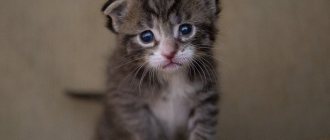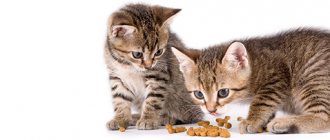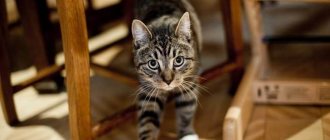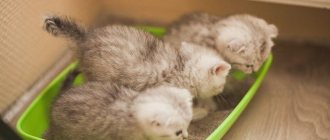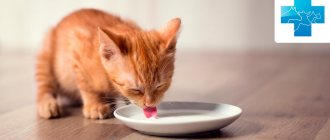Cats are wonderful, caring mothers. They give birth easily, and the litter averages 4-8 babies. If the kittens are not weaned, they continue to feed on their mother's milk until they are 3-4 months old. The owner may not worry at all about complementary feeding and litter box training: the clever cat herself will lead the grown-up babies to the bowl and teach them how to use the toilet. Unfortunately, the picture is not always so rosy.
What can go wrong:
- The cat died (during childbirth, during an emergency caesarean section, was hit by a car, or simply disappeared when kept for free);
- Postpartum endometritis requires surgery and antibiotic treatment, and the cat is very weak;
- The cat refuses to feed the kittens, is aggressive, tries to kill them;
- Maternal mastitis (inflammation of the mammary glands);
- The kittens were picked up or rescued (sometimes newborns are simply thrown into the trash), the mother is missing;
- The cat and cubs have a blood type conflict (this is possible, for example, in the British or Scottish breed).
If the kittens are left without a mother, first of all you need to try to find a wet-nurse cat. However, it is a matter of luck. The search may take several days, or it may not be possible to find a nursing cat at all. In such a situation, the owner must know how to take out newborn kittens without a cat.
It's difficult, but it's real. No matter how small the babies are, with proper care they will survive, grow up and live a long life.
Author of the article: Olga Shiltsova, practicing veterinarian, author of the books “Dachshund of Fate” and “Tails of Fortune”
Temperature regime for newborn kittens
It is necessary to feed orphaned kittens as early as possible, so that no more than a day passes after birth. But even more important is to keep them warm. Newborns cannot regulate their body temperature and are at risk of hypothermia outside their cozy den.
A heating pad will replace your mother's warm side. If you don’t have a special rubber heating pad, you can take a regular plastic bottle. The container is filled with boiling water and wrapped in a terry towel in several layers. This way the kitten will not get burned, and the water will cool more slowly. Depending on the temperature in the room, the hot water will have to be changed. In an apartment where it is about 20o, the heating pad keeps warm for about 6 hours. If the kittens are restless and huddle together, check the temperature of the heating pad.
For the first week, you should always have a heating pad on, change the water even at night. It becomes unnecessary when kittens reach one month of age. But knowing the love of cats for warmth, you can continue to apply the heating pad longer.
If there are a lot of kittens, then the box should be large. But then the blind kitten may get lost, bumping into the wall, and freeze. To prevent this from happening, you need to place bottles of hot water against each wall, and leave a free space in the center where the kittens can crawl. The cubs can simply snuggle up to the heating pad, or they can climb onto it and sleep on top.
Features of caring for orphan kittens
It is important to ensure that babies are always warm. If the kittens are shivering and their paw pads are cool, it means that the temperature conditions are not suitable for them. The box should be placed close to the radiator (but not close); if there is no battery, you can put a warm heating pad wrapped in a towel in the “nest”. The recommended temperature of the room where little orphans are kept is not lower than 24 oC.
It is important to understand that newborns have weak immunity. They must be protected as much as possible from infection and colds:
- always wash your hands before picking up a kitten;
- use only sterile feeding utensils;
- protect animals from drafts (the box should have high sides and not stand under an open window or opposite the front door).
Immediately after birth, the kitten still does not know how to empty itself. The cat helps him with this. In the absence of the mother, the person will have to take care of stimulating the digestive and excretory systems. After each feeding, you need to place the kitten on its back and stroke its belly, massage under its tail with a cotton pad moistened with warm water. After about 2-3 weeks, the kitten will be able to go to the toilet on its own (after each act of defecation or urination, it must be cleaned, since the baby still does not know how to wash itself with its tongue).
Video: how to help a kitten go to the toilet
Setting up a den for newborn kittens
Even the tiniest, still blind kittens can scatter in search of their mother, food or a source of warmth. To avoid trouble, it is necessary to exclude the possibility of escaping from the “nest”. The traditional, time-tested option is a cardboard box. Newborn kittens will not soon be able to get out of it on their own. The box should not be a shoe box, but with high walls.
Cardboard is a warm and safe material, and if the box becomes unusable, you can simply throw it away and replace it with a new one. An alternative is a deep plastic box or container, but in this case the ventilation is worse, and the container itself will have to be washed and disinfected periodically.
Place bedding on the bottom. A convenient option is disposable absorbent diapers, but the downside is that it can bunch up and clump if you do not attach it with tape or an adhesive edge. Fleece has proven itself to be excellent - it dries quickly, is warm and soft. Woolen products are absolutely not suitable, although they are often placed on kittens for “entourage”. The claws may get tangled in the fur, causing injury to the kitten. In addition, babies acquire the bad habit of sucking wool and may swallow thread.
Preparatory stage
A newborn kitten is very fragile. Therefore, feeding him must be taken with full responsibility. All ingredients must be fresh and of high quality. A homogeneous structure can be achieved by vigorous stirring. For the first three days, it is better to feed kittens from a pipette, holding it at an angle of 45°, and after that - with a syringe or a special bottle.
All items are sterilized after each feeding. The remainder of the mixture creates a good environment for bacteria to multiply. When ingested by a kitten, they cause various diseases that are fatal.
The finished mixture is stored in the refrigerator for 24 hours and heated to a temperature of 36° before use. After a month of life, babies begin to be actively fed. To do this, use porridge with milk , and then cook cereals with the addition of chopped meat and vegetables.
It is important to follow the feeding schedule and dosage. Overfeeding is harmful, since the kitten’s gastrointestinal tract is weak and cannot cope with large amounts of food. Cow's milk should not be given in its pure form, as it is poorly digestible. Diluting it with water is also a bad idea and can cause serious health problems.
You should not use fatty dairy products, for example, 33% cream. Pork and fresh fish can be infected with helminths, and therefore they are also prohibited. Sausage and frankfurters are made from low-quality raw materials and contain a lot of spices - they are not suitable for children.
Is it possible to keep newborn kittens together?
If there are several kittens, they are usually kept together. This makes it easier for babies to stay warm by snuggling together. Living warmth and the presence of relatives calms and creates a feeling of security.
But there are exceptions to every rule. During the first week, kittens should not be left with each other unattended, as their umbilical cord has not yet healed. Up to the age of one month, observe how babies interact with each other. Without round-the-clock access to the mother's breast, hungry kittens can cling to each other. This can be very dangerous - babies leave each other serious bruises, most often in the genital area and abdomen. They can suck ears and tails. If nothing is done, inflammation begins, especially in weak kittens.
To prevent kittens from sucking each other, they need to be fed and picked up as often as possible. But most often we have to separate the kids. Be careful.
The sucking reflex persists in orphan kittens for a very long time. Sometimes a cat raised without a mother sucks the owners fingers, earlobes, clings to the skin of the hands or chews hair until death.
Alternative option
In order to feed small kittens, you can use a nurse cat. You need to find an individual that has already given birth to cubs, and give her additional babies. Foundlings should be placed in the basket at the moment when the new mother leaves. They are carefully rubbed with bedding - this will allow them to become saturated with the smell. After this, the cat will calmly accept the newcomers and take care of them.
In some cases, it is enough to put the orphans on the floor, they will begin to meow pitifully, and the maternal instinct will take over: the cat will take them to her.
There are stories of mothers raising children other than their own in this way. For example, a pug dog in the Kuban Zoo fed tiger cubs.
Nutritional needs of newborn kittens
Kittens are born without a fat layer and without a reserve of carbohydrates (in adult animals, this role is played by glycogen in the liver and muscles). They need regular, nutritious food and eat very often.
Babies do not yet have free hydrochloric acid in their stomach (it begins to be produced by the age of 3-4 weeks). Therefore, it is unacceptable to start complementary feeding before 3 weeks of age. Newborn kittens can only eat milk. But not just any milk!
When preparing a diet for a small kitten, you need to focus on the composition of cat's milk. Its main feature is its high protein and fat content. Neither cow's nor goat's milk can replace a kitten's mother's milk, which contains about 10% fat and 11% protein. By comparison, cow's milk contains only 3.5% protein. The content of milk sugar, lactose, also differs. There is much less of it in cat milk.
In addition to proteins, fats and carbohydrates, a kitten needs vitamins and minerals for normal development. This includes a special fatty acid – docosahexaenoic acid (DHA, or DHA). It belongs to Omega-3 fatty acids, a good source of which is fish oil.
Contrary to popular belief, infant formula is also not suitable for feeding kittens. The nutritional needs of human and feline babies are very different.
You can buy formula for kittens at a pet store or veterinary pharmacy (cat's milk substitute), or prepare it yourself at home.
How to take care of a kitten
Babysitting a newborn without a mother cat is not an easy task, but it can be done.
You have to fulfill several conditions to successfully raise a kitten at home:
- Find a mixture similar to cat milk;
- Observe the temperature regime (food temperature - 36-38 degrees);
- Keep the cat warm, from 25 to 30 ° C and wipe it after feeding;
- Follow the kitten's body signals. Diarrhea, constipation or nausea in the patient indicate that the mixture is not suitable.
There are many cases when a cat dies during childbirth. It happens that she refuses offspring. Nervous cats sometimes show no interest in their offspring and are apathetic or aggressive. Getting a mustachioed shrew to feed newborns is almost impossible, and even dangerous for babies.
If a mother cat does not have the strength or patience to feed her babies, you can try to find a replacement for her among the neighbors. Another good news: a miniature dog can also cope with the role of nurse. Maternal instinct will work in such a way that someone else's animal will begin to take care of the little cat. Even a cat is suitable for care, because in addition to food, the kitten will have to be provided with warmth and hygiene. Before entrusting a four-legged orphan to the “teacher”, make sure that she has no infectious diseases. You should not expose a newborn to unvaccinated cats, and it is also important to carry out prevention against worms.
Let's assume we managed to find a nanny. But it may turn out that she feeds her foster child poorly and gets irritated at the sight of a stranger. Perhaps a nursing cat does not have enough experience. In this case, it will be better for you to take the baby out of harm's way. Every veterinary pharmacy is replete with mixtures for crumbs.
Milk replacers for newborn kittens
Feeding newborn kittens has now become much easier - you can buy ready-made milk formula for kittens at a pet store. I recommend this particular option - an industrial substitute for cat milk, without being tied to a specific company. All of them have proven themselves well.
- Royal Canin Babycat Milk (includes measuring spoon, bottle and several nipples with holes of different diameters)
Royal Canin cat milk replacer
- Beaphar Kitty-Milk (there is a measuring spoon, but the feeding kit will have to be purchased separately)
Beafar cat milk replacer
- Gimpet Cat-Milk (no measuring cup, you can use a regular spoon, diluting the mixture 1:3 with hot water)
The dosage indicated per 100 g of kitten weight is not one-time, but daily. This amount should be evenly divided into several feedings.
Weigh your kitten to get an idea of how much food he needs.
Feeding methods
Kittens at the age of two weeks need to be fed correctly. You cannot turn the kitten over on its back. Place your fluffy on your lap on a disposable diaper. Lift your muzzle slightly by the scruff of the neck.
It is best to use a container or box with low sides. Cover the bottom with a soft cloth. Place the kitten's front legs on the bottom, but so that his front paws rest against the side. Over time, the kitten will choose a comfortable position for eating.
Important! After eating for up to 3 weeks, kittens burp. Therefore, before the massage, place the kitten on your chest and stroke its back for a few minutes until it burps.
It is best to feed babies from bottles with a nipple or pipette. This way the milk supply will be delivered evenly or drop by drop. If your kitten has a weak sucking reflex or is having difficulty sucking formula from a bottle, use a dropper.
How to prepare kitten formula at home
Often, orphan kittens end up in people's care quite suddenly. What if the industrial cat milk substitute is not sold anywhere (delivery is only possible from another city), or the store is simply closed for the night, or there is simply no money?
The first thought is to give the kittens regular milk, some recommend goat milk. Although this is not suitable food for them, it is acceptable as “first aid”. But 10% cream is much better. At first glance, they are very fatty; cream seems like heavy food to us. But cat milk contains 9-11% fat, and 10-11% cream is what you need. They will be absorbed better than “watery” milk.
Cream is absorbed better than milk
In the future, you need to prepare a mixture for kittens that is balanced in nutrients. Its main difference from regular cream will be the high percentage of protein. For feeding kittens from birth to 3 weeks, mix:
- 380 ml cow's milk 1.5%
- 25 g raw egg yolks (the amount depends on the type of egg)
- 15 g vegetable oil
- 75 g low-fat lactose-free cottage cheese
- 1.5 g evening primrose oil (source of vitamin E)
- 200 mg taurine
- 5 g vitamin and mineral supplement (20% calcium)
Mix with a blender and heat to 35°C.
Healthy diet for a kitten
Proper nutrition ensures proper growth for kittens. When breastfeeding, they receive all the necessary vitamins and microelements. When artificially feeding with formulas, additional complementary foods must be introduced.
About 3 weeks after birth, kittens begin teething. This is when you need a supply of vitamins. Some products are starting to be introduced.
The kitten's diet consists of:
- Milk porridge made from oatmeal, rice, semolina;
- Chicken, ground beef or special meat food for kittens;
- Boiled egg;
- Cottage cheese with the addition of cream, honey, raw egg yolk;
- Meat products from the baby food series.
You can't add sugar because it disrupts metabolism. Complementary foods should be given 4 times a week.
Regime and rules for feeding newborn kittens
Newborn kittens need to be fed as often as possible - this is an axiom. It is natural for them to eat often, but little by little. Unfortunately, one person simply cannot provide orphans with round-the-clock access to a bottle.
How often should kittens be fed depending on age:
A newborn kitten sucks until it is satisfied, and then falls asleep again. Feeding itself does not take much time, usually no more than 5 minutes.
Kittens eat often, but little by little
1 week – every 2 hours, including at night. More often if the kittens wake up and squeak (sometimes you have to feed them every hour).
Week 2 – every 3 hours, at night every 4 hours.
Week 3 – feeding every 3-5 hours, at night the interval can be 6 hours if the kittens do not wake up.
4th week – kittens are fed on average 4-6 times a day (every 4-6 hours), by the end of the week they begin to introduce complementary foods.
Month-old kittens begin to eat special canned food
How to prepare the mixture
If you are using a commercial milk replacer, detailed instructions will be provided on the packaging. The general principle is this: boil water and let it cool to about 50°C. Pour the mixture powder into the water, stirring constantly so that there are no lumps. The prepared solution is poured into bottles. When the milk has cooled to 35-36oC, it is given to kittens.
Common mistakes: pour the powder with water, and not vice versa; use boiling water instead of hot water
It is not recommended to store the finished mixture. But this is perfectly acceptable if you keep it in the refrigerator. A pre-prepared solution at night is especially helpful. Then you only need to heat the milk to the desired temperature - in the microwave or in a water bath.
Be sure to check the temperature of the milk by placing a drop on your wrist before giving the bottle to your kitten.
How to feed a newborn kitten
Ideally, the kitten is fed from a special bottle with a nipple, and the diameter of the nipple hole varies depending on the age of the baby. In real life, buying such a bottle can be a problem. An alternative would be a plastic syringe without a needle.
The kitten is fed by holding it upright if it is very small, or lying on its stomach. It is strictly forbidden to place the kitten on its back. Kittens must suck the bottle or syringe nozzle themselves; pouring the mixture into them is unacceptable - it can get into the respiratory tract.
Kitten drinks from a bottle
Many newborn kittens die from aspiration pneumonia caused by improper feeding, and not at all from a draft or viral infection. No force feeding.
The bottle is held at an angle of 45°C, it should be comfortable for the kitten to suck. The muzzle will be raised up.
The correct position of the bottle is at an angle of 45 degrees
How much milk to give a kitten at one time
The amount of formula fed to a kitten depends on the age and weight of the baby. Kittens are usually fed ad libitum so that the sleepy baby falls off the nipple on its own. But sometimes overfeeding leads to digestive problems, and you need to at least approximately adhere to the standards indicated on the packaging of the cat's milk replacer.
In the first week the kitten will drink about 2-5 ml at a time, in the second week 5-10 ml, then 10-15 ml.
Cow's milk or baby formula is too watery for kittens. Their kitten will drink more, stretching its stomach and suffering from colic. Cat milk replacer is high in protein and fat. It is more concentrated, more nutritious. And you only need a little bit of it in terms of volume.
Kittens are not given water until they begin to lap from the bowl on their own.
Tummy massage
After each feeding, the kitten is helped to relieve itself. To do this, carefully massage the tummy clockwise. In addition, you need to massage the anus with a damp cotton pad or napkin, imitating the movements of a cat's tongue.
Urination should occur after each meal, and bowel movements on average 4 times a day. The stool should be light brown and soft. Kittens will only have formed stools when they start complementary feeding. The butt is wiped first with a damp and then with a dry cloth.
Kittens must poop from the first day of birth. If there are no stools, a veterinarian's examination is necessary. The kitten may have congenital underdevelopment or occlusion of the anus and other problems.
The kitten needs not only to be fed, but also to be helped to defecate.
Weighing
To make sure that kittens are digesting food and growing, they need to be weighed. In the first week it is better to do this daily. The weight gain should be about 15 grams. You can weigh babies using electronic baby scales or kitchen scales. If the scales are not equipped with a bowl, the kitten is placed in a container.
This kitten's eyes haven't opened yet. Weighing on a kitchen scale
This kitten weighs almost 700g and can eat dry kitten food
How often to feed a newborn kitten
The frequency of feeding kittens abandoned by a cat has long been determined by experts.
Until the fourth day of life, babies are fed every 2 hours around the clock. On the fifth day, the frequency changes: the baby can tolerate it for 3 hours. From the 14th day, only one night feeding is left, daytime feedings are left at the same interval. After 25 days of life, you need to feed 1 time at night; during the day, the interval between meals is 3-4 hours. From the 35th day, a gap of 4 hours is left during the day, and night feeding is removed.
If you have the fate of feeding a newborn kitten in the first days, then do not overfeed the cub: he is given 3-4 ml per feeding. With growth, the interval between meals and the single dose increase.
What to do if your kitten is constipated
Irregular bowel movements are the most common problem in newborn bottle-fed kittens. Owners complain that it is not as difficult for them to feed the brood day and night as it is for them to force the babies to poop.
For good digestion, you need to use a professional cat's milk replacer and regularly massage the kittens' belly. But what if kittens are still constipated?
Veterinarians prescribe petrolatum oil orally 2 times a day. And safe laxatives are given in a course every day, for example - Lactusan. If there has been no stool for a long time, it becomes dense and the kitten will not be able to poop on its own. Then you need a small enema (1.5-2 ml). Cool water is mixed with Vaseline oil and injected into the anus using a syringe without a needle.
If constipation alternates with diarrhea, and the tummy is unnaturally round and swollen like a drum, the cause may be a huge number of worms in the intestines.
Stray kittens are always infected with parasites
Tips for feeding a kitten
Raising kittens without a cat, especially for the first time, requires a lot of effort, patience, and skills. The following tips will help you overcome difficulties and tell you how to get out of a difficult situation.
- The kitten has eaten the amount allotted for its age, but continues to suck. How to proceed? Immediately a fear arises - he doesn’t have enough, he hasn’t eaten enough, I must add. It's worth checking your tummy. Round and elastic, it indicates that there is enough food. The kitten just got carried away, or didn’t realize that it was full.
- The baby does not drink the dose prescribed for his age. Perhaps he is sick. Or this is a feature of the body - it eats less food. If he behaves on par with the other kittens and does not seem weak, then everything is fine. Otherwise, you need to show it to a specialist.
- The kitten must be fed at night. This is a feature of the body of a newborn, like a baby. If this is not done, digestion will be disrupted and health problems will arise. At night, kittens will meow, look for food, and not sleep.
- The portion should be divided into 2 times. Initially, the baby pounces on the food and sucks greedily. Having drunk it all, he does not realize that he is full and feels hungry. Then proceed as follows. They feed one kitten; when it drinks half of it, they stop feeding it. They move on to the second baby. They do the same. Then they return to the first baby again. In this case, he will eat calmly, and the feeling of fullness will come on time.
- The mixture is prepared in portions before feeding. The digestive system is such that it cannot tolerate “yesterday’s” or “morning” food. There is bloating, fermentation, pain. It is better to heat food in a water bath.
- The kitten does not take the pacifier, pipette, or the tip of the syringe; you must carefully insert it into the mouth and squeeze out a little of the mixture. To stimulate sucking, you need to stroke his back and forehead.
- When feeding a kitten, you need to make sure that the head does not tip back too much. In this case, he does not have enough breath, which leads to difficulties. The kitten may choke, choke, or suffocate.
- To determine whether the baby is full or not, you need to observe his behavior. A well-fed kitten will turn away from the pipette and calmly go to bed. A hungry baby will squeak, suck on his brothers, and look for a pacifier.
- It is better to buy milk for preparing the mixture at the market, not in the store. In this case, you can be sure of its natural origin and quality. If the milk contains food additives, preservatives, or water, it will not benefit the kitten. In addition, the mixture prepared according to the recipe will be low in calories, the baby will not get enough of it.
Feeding a kitten without a cat is a very labor-intensive and lengthy process. You need to quit all your business, not go to work, feed the babies every 2 hours day and night. The sacrifices must be justified.
An interesting fact remains that when such a situation arises in rural areas, kittens are fed fresh cow's milk from a pipette for literally a week. When they get to their feet, offer a small bowl. No special care. As a result, they grow up alive, playful, and healthy. They determine their own norm.
https://www.youtube.com/watch?v=r2ZCM15oLgw
Is it true that artificial kittens get sick more often?
There is a persistent myth according to which kittens deprived of their mother's milk will suffer from some illness throughout their lives. Allegedly, they have extremely weak immunity and a digestive system that has been torn since childhood.
As usual, there is some truth here. Breast milk is really difficult to replace with artificial formula, and the consequences of such feeding can appear years later. But think about this - millions of human babies are raised on formula and are no different from those people who were breastfed as children.
Kittens receive protection from infections from mother's milk only in one case - if antibodies to viruses are in the blood of the cat itself. This is called colostral immunity. If a nursing cat has not been vaccinated, then her kittens are just as defenseless against viruses as bottle-fed kittens. Babies receive preventive vaccinations as early as possible (the first at 2 months with revaccination at 3 months). And complementary foods are introduced as quickly as possible, nevertheless continuing to give a cat's milk substitute for up to 1.5-2 months.
Rumors about the illness of orphaned kittens have a different background. For example, a pregnant cat was starving, which prevented the correct formation of the fetuses.
If the cat lived in good conditions, and the kittens received good genes from both parents, then artificial feeding will not prevent the babies from growing into beautiful and healthy animals.
Types of dry food for kittens
All finished products, which are offered by various manufacturers, are divided into classes. Each has both pros and cons.
Economy class food
These are the brands that constantly appear in advertising and are presented in a wide range on the shelves of any supermarket: Kitikat, Whiskas, Sheba and others. The products of the listed brands are affordable, but the composition is not always up to par. Disadvantages include:
- low meat content;
- the presence of various taste stabilizers, thickeners, etc.;
- the presence of cereals harmful to the cat’s body, for example, corn.
But the variety of different flavors and textures, combined with low prices, is helping to popularize inexpensive brands. In order not to treat your beloved pet later, it is better to avoid economy-class food or give it very rarely.
Premium products
This class includes the brands “Hills”, “ProPlan”, “Akana”, “Royal Konin”. The composition contains a higher percentage of pure meat, grains and vegetables. The food is enriched with vitamin and mineral complexes and is suitable for a complete daily diet. There are specialized lines for small kittens, spayed and neutered, as well as older animals. The cost is higher compared to economy segment products. When buying such food, the owner can be sure that the cat will not only be well fed, but will not “earn” sores.
Holistic
These are products of the highest quality, containing only natural meat without processed products. The manufacturer guarantees that the animals are raised in excellent conditions and are fed only healthy food. The finished products do not contain chemical additives, GMOs, soy, or corn. The cost of food in the holistic segment is very affordable.
A small kitten needs tireless care and frequent feeding. This is especially important if the pet was left without maternal affection at an early age. Organizing care is difficult, but quite possible. The feeding schedule changes as the baby grows and is 8-10 times in the first 2 weeks of life; 7-8 times a month; 6-7 – at two months; 5 servings per day at 3-4 months and 2-3 for adolescents and adult animals. Newborns and toddlers are fed only milk (goat's milk) or milk substitute. Older adults require more food, so complementary foods are introduced from 1.5 months. For full development, a kitten needs a balanced diet, so you can either buy ready-made (dry and wet) food, or diversify natural food. Whether your pet will be healthy, cheerful and active directly depends on the quality of food, which the owner must take care of!
